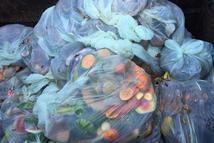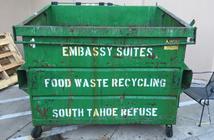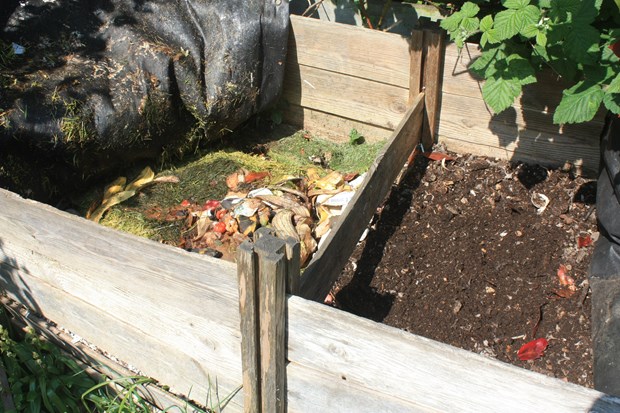saveourplanetearth.com
Call us: (775) 831-1331
Composting
Many of us already recycle but there is one more thing we can do to reduce household waste and that is composting.
Not only does composting reduce waste, the process will create a product that your soil will appreciate.
There are commercial products available that can help you in your quest to compost from fancy bins to tumblers to pail systems designed to go under your sink; however, you can compost using a pile on the ground.
We live in an area surrounded by wildlife, so in composting, we need to be careful to not create a wildlife attractant. The black bear has a powerful nose and a pile of rotting food is an enticing smell to him. Chopping materials with a shovel and keeping them properly stirred should eliminate this problem.
A successful compost heap will have a variety of ingredients: green, brown, water and air. Green materials, high in nitrogen, include grass clippings, weeds, fruit and vegetable scraps, coffee grounds, tea leaves and hay.
Brown materials are high in carbon, providing fiber for your compost and include wood chips, sawdust, straw, dried leaves and pine needles. The smaller the particles that go into your compost, the faster it will decompose.
Layer these items, add enough water to make damp, but not wet. Add air by mixing or turning the pile, once a week or every other. Do so by moving the pile from point A to point B, vigorously turning it with a pitchfork or shovel or use an aerating tool that stirs it from within, similar to an egg beater.
A compost heap that is fed a proper assortment of ingredients, given the correct amount of water which is regularly aerated will begin to heat. This means the process is working.
You can add paper towels, newspaper, hair, eggshells and cardboard; basically anything that is organic. Just be careful to keep a balanced mix of nitrogen to carbon. Do not add human or animal feces or meat products.
For those who want to start small, consider an indoor worm-composting bin, a process known as vermicomposting, utilizing red wiggler worms.
These worms busily eat your table scraps, and produce waste called castings, which further enrich the compost. Vermicompost contains a greater variety of beneficial microbes than traditional compost, making the nutrients more available for the plants.
There are ready-made bins on the market, but find directions to create your own at organicgardening.com. I found red wiggler worms at hayneedle.com. Find links on my website saveourplanetearth.com for these and other products.
Eventually composting service may be made available through our trash service companies but for now, a program is underway in South Shore, and a pilot program is being conducted in the Tahoe/Truckee region.
Tahoe Truckee Sierra Disposal, partnering with Placer County Environmental Engineering and the Town of Truckee, conducted a 4-week pilot test in September with 10 participating restaurants and grocers, and will conduct another study in mid-February.
As this was a test to determine the costs, feasibility and logistics, materials collected were ultimately disposed of as per normal trash collection procedures; however, two loads of material were taken to RT Donovan in Sparks, Nevada, a landscape materials company, to ensure the material collected was of good quality for composting and it was.
South Tahoe Refuse partnered with Embassy Suites to begin accepting compostable materials from commercial venues. The program has morphed since then; for one, Embassy Suites became Lake Tahoe Resort Hotel, whose program is now orchestrated by Marc Hage, Director of Engineering for Lake Tahoe Resort Hotel.
Lake Tahoe Resort Hotel routinely provides 4 yards of compostable materials per week, aided by rigorous employee training and the watchful eye of Executive Chef, Salvador Delgado, who is passionate about properly collecting materials to be made into compost.
Marc Hage’s commitment to composting dates back to his childhood. His father, Marvin Hage, back in the 1950s in Detroit, Michigan, maintained a compost heap in his backyard and used the results of his efforts to fortify the family garden.
The materials collected by South Tahoe Refuse are taken to Full Circle Composting in Minden, Nevada, where it is turned into compost, which is then sold to area farmers.
Other businesses participating in this composting program include Sprouts Café, Zephyr Cove Resort, South Tahoe culinary arts class and several elementary schools.
These businesses are proud of their participation in this program, as well they should be. This is an example of individuals and businesses working to be as environmentally responsible as possible, even if it takes a little more time and costs a little bit more.
Bags of fruit and vegetable scraps, ready for the compost bin.
Photo courtesy of Marc Hage
Director of Engineering
Lake Tahoe Resort Hotel
A 4-yard bin, filled weekly with compostable materials, at the Lake Tahoe Resort Hotel, formerly Embassy Suites.
Photo courtesy of Marc Hage
Director of Engineering
Lake Tahoe Resort Hotel
Reader Emily, a student inspired by a school project, submitted this suggestion:





